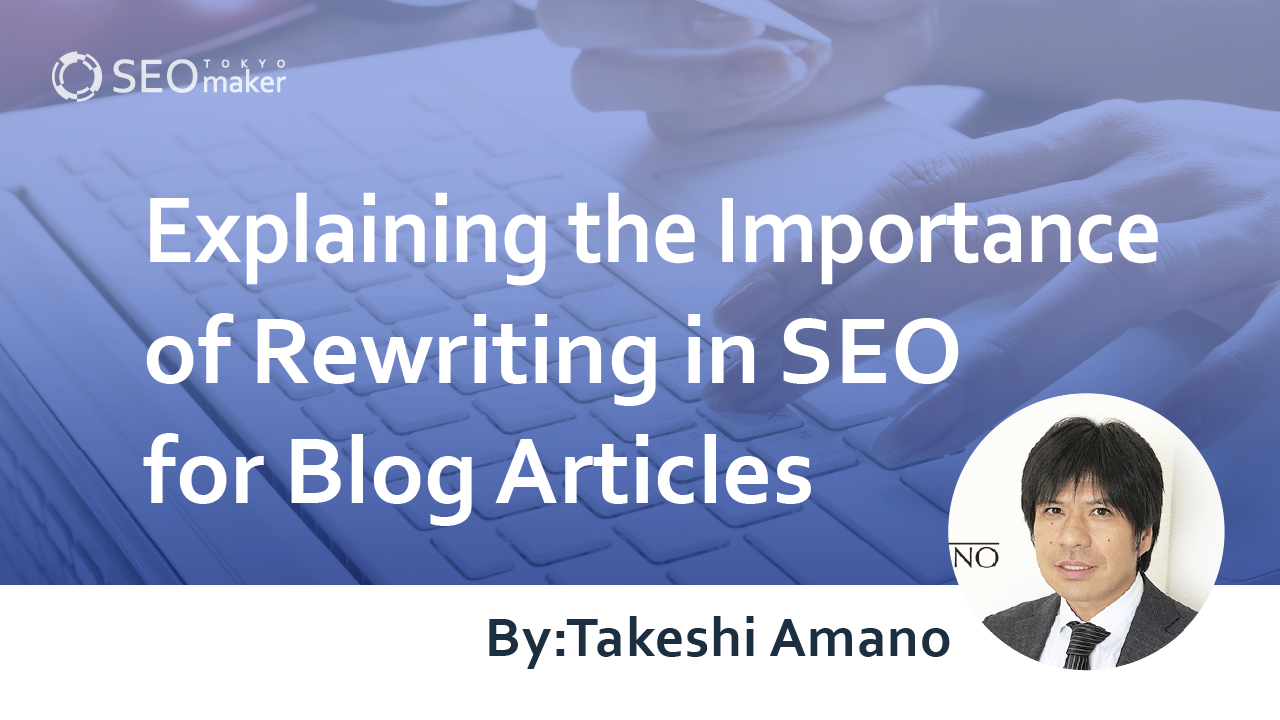Explaining the Importance of Rewriting in SEO for Blog Articles
contents
- 1 Rewriting in Blog Articles
- 2 Purpose of Rewriting Blog Articles
- 3 Methods for Rewriting a Blog
- 4 Benefits of Rewriting Blog Articles
- 5 Disadvantages of Rewriting Blog Articles
- 6 Steps to Rewrite a Blog Article
- 7 Key Considerations for Rewriting Content to Rank Higher
- 8 Points to Consider When Rewriting Blog Articles
- 9 Summary

Rewriting blog articles can enhance user convenience. Particularly for articles with low search rankings, rewriting can boost SEO effectiveness and potentially increase rankings. Without rewriting, it’s challenging to determine the quality of an article or grasp the constantly changing needs of users, which could lead to a drop in search rankings.
To continually meet users’ needs, it’s crucial to periodically rewrite blog articles. This discussion will explore the importance of rewriting.
Rewriting in Blog Articles
Rewriting involves editing the content or title of an article to refresh it with new information. As users’ needs change regularly and new products and services continuously emerge, rewriting helps ensure that articles remain relevant and widely read over time.
Effective Timing for Rewriting
An effective time to rewrite is when search rankings begin to drop. A decline in rankings often has underlying reasons, and addressing these can sometimes lead to improved rankings again. If you’re discussing products or services and new offerings become available, it’s advisable to rewrite those articles. If left unattended, the content will continue to promote outdated products or services.
Considering both user convenience and SEO strategies is crucial when deciding to rewrite blog articles. Since Google prioritizes user-first content, rewriting with user convenience in mind is ultimately effective for SEO.
The Importance of Rewriting
Rewriting an article allows Google to re-evaluate it. For instance, if the rewritten article is judged to be of higher quality than the original, it could achieve higher search rankings. Additionally, because information constantly changes, retaining outdated information means you cannot provide accurate content to users. Regular rewriting is necessary to ensure the delivery of valuable information to users.
Precautions Before Rewriting
Even when rewriting, it’s essential to remain conscious that Google evaluates web pages primarily on whether they put users first. Therefore, merely writing what you want on a blog page without considering the user will not be valued by Google, rendering the rewrite ineffective.
Reference: “What is Rewriting? Workflow and Tips for Enhancing SEO Impact
Purpose of Rewriting Blog Articles
Blog articles may be rewritten for several reasons as follows.
- Improving Conversion Rate (CVR)
- Updating with the latest information
- Enhancing SEO strategies
Improving CVR Through Rewriting
Rewriting content to better meet readers’ needs can lead to an increase in Conversion Rate (CVR), such as in purchases or document requests.
Updating with the latest information
Most blog readers seek new information, so it is crucial to provide the latest content through rewriting.
SEO Strategies
Adjustments like ensuring the title and content align, and embedding keywords within the text and title, can be implemented as SEO strategies. Providing up-to-date information also serves as an SEO tactic. Rewriting a blog article allows Google to re-evaluate it, potentially improving the search ranking of articles that previously ranked low.
Reference: “What is SEO? [Latest SEO Guide] Explaining Strategies for Ranking Higher”
Methods for Rewriting a Blog
When rewriting a blog, consider the following steps.
-Choose articles that are not ranked higher
-Rewrite the title
-Rewrite the body
-Adjust internal links
Select Articles That Are Not Ranking High
Rewriting generally involves modifying articles that are not currently performing well. Therefore, it is crucial to select articles that are not ranked high in search results.
Rewrite the Title
Simply rewriting the title can serve as an SEO strategy. For instance, if the content does not match the title, or if the title lacks keywords or is too long, it should be rewritten.
It might simply be that the title is not appealing enough to make users want to read it. The title is the face of the content, and it can make users want to read it.
Rewrite the Main Text
Even if the title is captivating, if the content does not match, there’s a risk that the search ranking might drop. Please check whether the text is easy to read, provides valuable information, and offers the latest data. Since user needs change, it is important to regularly review articles that do not rank well.
Adjust Internal Links
Internal links are pathways that lead to other pages within the same website. By setting up internal links, Google may recognize the relevance between the articles, potentially increasing their value. Furthermore, this can encourage readers to explore related pages on your site, effectively boosting your SEO efforts.
Benefits of Rewriting Blog Articles
The benefits of rewriting blog articles are following 2 points.
- Utilizing Existing Articles
- Expectations of Influx from New Keywords
Utilizing Existing Articles
Rewriting allows you to leverage existing content, eliminating the need to create new articles from scratch. Even articles that are not currently ranked high can be improved to rank higher through rewriting.
-
Experiences of Influx from New Keywords
Even if the article content remains the same, rewriting can attract traffic from new keywords. Articles that previously did not align well with keywords can attract more visitors if rewritten to match relevant keywords and titles better.
Disadvantages of Rewriting Blog Articles
Rewriting blog articles can also have the following disadvantages.
– Difficult to Measure Effectiveness
– Difficulty in Deciding Which Articles to Rewrite
Difficult to Measure Effectiveness
It can be challenging to measure the effectiveness of a rewritten article. Using tools can be effective for this measurement.
Difficulty in Deciding Which Articles to Rewrite
Not all blog articles should be rewritten, but deciding which articles to rewrite is not straightforward.
Steps to Rewrite a Blog Article
Typically, the process for rewriting a blog article involves the following steps.
-Selection of Articles
-Analysis of the Articles
-Implementation of the Rewrite
Selection of Articles
First, identify which blog articles should be rewritten. It’s common to choose articles that are not ranking high or are not attracting much traffic for rewriting.
Analysis of the Article
There are various ways to rewrite an article, ranging from minor changes, such as modifying the title or parts of the content, to major revisions. Analyzing the article is crucial to select the most effective rewriting approach.
Implementation of the Rewrite
Once the article is selected and the purpose and content for rewriting are analyzed, proceed with the rewriting. It’s recommended to periodically rewrite articles depending on their content.
Key Considerations for Rewriting Content to Rank Higher
Content that ranks well in search results typically has the following characteristics:
- EAT (Expertise, Authoritativeness, Trustworthiness)
- Search Intent
- Originality
When rewriting a blog, it’s important to focus on these three aspects.
E.A.T.
According to Google’s Search Quality Evaluator Guidelines, the following three concepts are critical
- Expertise
- Authoritativeness
- Trustworthiness
Providing specialized, authoritative, and reliable information leads to positive evaluations from Google. High expertise in a specific area tends to facilitate solutions to user problems. However, even if the information is highly specialized, it may be rated lower if it is not presented in a user-friendly manner.
Regarding authority, academic papers are a prime example. To enhance authority, it is crucial to cite reliable websites as references. Typically, information from government sources or official organizations is commonly included.
Reference: “What is EAT? An In-Depth Explanation of Google’s EAT Criteria and How to Meet Them”
Search Intent
Search intent refers to what information the user is looking for when they make a search. Essentially, writing articles that match the search intent satisfies user needs.
There are mainly four types of search intent.
- Know type: The user seeks knowledge related to the search keywords.
- Go type: The user wants information about a location, access details, menus, reviews, etc.
- Do type: The user wants to know how to do something related to the keyword.
- Buy type: The user intends to purchase a product online.
Even if an article matches the search keywords, it may be irrelevant if it does not align with the user’s intent. For example, providing the history or origin of a product might not satisfy a user who is looking to purchase that product.
Originality
Providing unique information that is not available on other sites can lead to higher evaluations from Google. Websites that copy content are at risk of penalties.
Points to Consider When Rewriting Blog Articles
When rewriting blog articles, it is important to consider the following.
After confirming the search ranking, check the following before rewriting an article:
-Prioritize content
-Prepare internal systems
-Remove unnecessary content
-Do not rewrite articles that are high in search rankings
-Regularly check after rewriting
-Avoid excessive rewriting
-Some articles do not need rewriting
Rewrite articles only after their search ranking becomes clear
This is because, fundamentally, there is no need to rewrite articles that already rank high.
Focus on Content
Google maintains a user-first approach, meaning the blog should contain content that is easy to read and beneficial for the user. When rewriting content, it’s crucial to prioritize the quality of the content.
Remove Unnecessary Content
Unnecessary content can confuse readers. It is recommended to remove any parts that seem superfluous.
Do Not Rewrite High-Ranking Articles
Articles that are already ranking high should not be rewritten. Rewriting is typically done to improve the rankings of articles that are not currently performing well.
Regular Checks After Rewriting
Even if an article achieves a high ranking after a rewrite, neglecting it could cause it to drop in rankings again. Additionally, because users need continuously change, it’s important to regularly check and update the content even after rewriting.
Not All Articles Need Rewriting
Rewriting is not always necessary for all content. For example, articles that already have high search rankings or high Conversion Rates (CVR) are performing well and do not need to be rewritten. Similarly, articles with low bounce rates are being read by many people and should not be targeted for rewriting.
Summary
The articles suitable for rewriting are those with low search rankings or CVR, i.e., those that are not performing well. Changing the title or content of such articles can improve Google’s evaluation and potentially increase their visibility in search results. However, articles that already have high rankings or CVR, or those with low bounce rates that are well-read, should not be rewritten. While rewriting is important, selecting the right articles to rewrite is crucial.










![What is a Description? Explaining the Meaning, Writing Style, and Changing Word Count – [2023 Edition]](https://www.switchitmaker2.com/en/wp-content/uploads/2024/09/what-is-description.webp)










